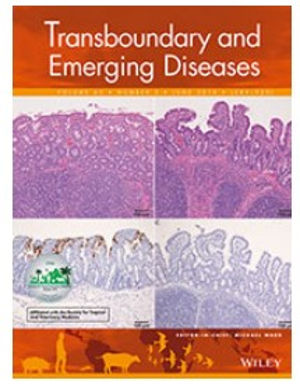By Joe Montgomery
An image from the new review article by Kansas State University swine disease researchers in the College of Veterinary Medicine has been featured on the cover of the latest issue of the international journal Transboundary and Emerging Diseases: "Swine enteric coronavirus disease: A review of four years with porcine epidemic diarrhea virus and porcine deltacoronavirus in the United States and Canada."
In their article, Megan Niederwerder, assistant professor of diagnostic medicine and pathobiology, and Dick Hesse, professor and director of diagnostic virology, review the recent introduction and spread of porcine epidemic diarrhea virus, or PEDV, and porcine deltacoronavirus, or PDCoV, in the United States and Canada.
Although these two viruses were recently introduced in 2013 and 2014, respectively, both viruses are now endemic in United States swine herds. The authors review current and historical research on the viruses, including clinical disease in different age groups, postinfection viral shedding, the long-term impact of disease on growth and production, introduction and transmission risks, and herd management strategies.

"These two viruses have caused and continue to cause significant economic and production losses within the U.S. swine industry," Niederwerder said. "Within the first year after PEDV was introduced, approximately 10 percent of the U.S. herd died due to the disease, primarily affecting very young piglets within a few days of age. Although these viruses cause the highest mortality rates in neonatal pigs, there is also evidence for long-term production impacts on older pigs."
One of the most revealing components of the manuscript was a survey of swine professionals conducted by Niederwerder and Hesse to compile information and opinions from stakeholders on the current swine enteric coronavirus situation in the field. Although control strategies varied significantly among respondents, the majority of stakeholders believed that eradication of PEDV and PDCoV was possible.
"A primary goal of this manuscript was to complete a comprehensive review of the research performed thus far as well as highlight important gaps in our knowledge to understand how best to manage and control these diseases," Niederwerder said. "For example, viral shedding can be intermittent and prolonged after clinical signs resolve in pigs. Understanding the factors that impact shedding will help in management and the potential future eradication of these diseases."
Source: kstate.edu